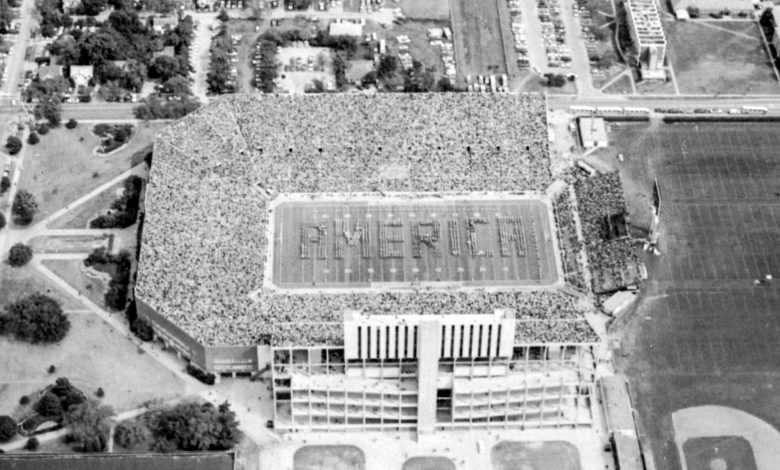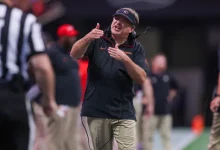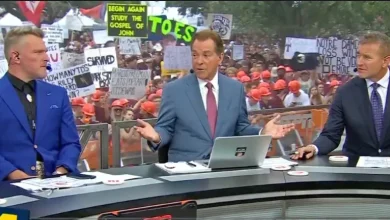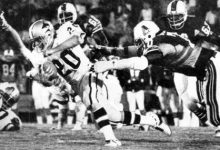Oklahoma City, November 25, 1944 – Oklahoma Sooners and Oklahoma A&M Aggies playing the annual Bedlam football game at Taft Jr. High Stadium. The crowd was estimated unofficially at 18,000. The Aggies won 28-6 and went to the Cotton Bowl on January 1st, where they shut out TCU 34-0.

On a crisp late-November afternoon in wartime Oklahoma City, a crowd of nearly 18,000 fans packed into Taft Junior High Stadium to witness a heated installment of the Bedlam football rivalry, one that would not only define a season but would help launch Oklahoma A&M—now Oklahoma State—into one of the greatest stretches in its football history.
In a game defined by bruising line play, opportunistic defense, and decisive momentum swings, the Oklahoma A&M Aggies defeated the Oklahoma Sooners 28–6, capturing statewide bragging rights and punching their ticket to the Cotton Bowl Classic in Dallas, where they would later shut out TCU 34–0 in a dominant postseason performance.
For those in attendance at Taft Stadium on November 25, 1944, it was more than just a rivalry. It was a moment of normalcy and civic pride during the height of World War II, when much of the country—including college football—was reshaped by the demands of the global conflict.
The crowd—made up of students, families, soldiers home on leave, and locals wrapped in overcoats and blankets—created a patriotic and emotional atmosphere. Wartime rationing and travel restrictions made large-scale sporting events rare, especially outside major cities, and the 1944 Bedlam game served as both competition and community gathering.
Despite the difficulties of wartime scheduling, the Sooners and Aggies were able to field competitive rosters thanks to a combination of student-athletes, military trainees stationed on campuses, and war-hardened coaching staffs who adapted to rosters that changed weekly.
Both teams came into the game with gritty, ground-based offenses and stout defenses—hallmarks of the era. The game plan for both sides was simple: win the trenches, protect the football, and control the clock.
But from the opening whistle, it was Oklahoma A&M that asserted itself.
The Aggies jumped out to a quick start with a 60-yard drive on their opening possession, capped by a short touchdown run behind their punishing offensive line. Their success on the ground set the tone for the day. OU’s defense, normally disciplined and physical, couldn’t stop the relentless north-south attack that A&M deployed.
By halftime, A&M had built a 14–0 lead, thanks to a second-quarter touchdown drive that chewed up valuable minutes and kept Oklahoma’s offense cold on the sideline.
The Sooners, led by head coach Dewey “Snorter” Luster, tried to respond through the air—a rarity in 1940s football—but A&M’s secondary was sharp, intercepting a key pass late in the second quarter that snuffed out one of Oklahoma’s best scoring chances of the game.
The third quarter brought more of the same. A&M’s backs pounded the middle of the Sooners’ front seven, and a long punt return set up another Aggie score, pushing the lead to 21–0.
The Sooners finally got on the board in the fourth quarter, when a broken coverage allowed OU’s lone touchdown of the day on a 25-yard pass play. But A&M answered quickly with a fourth touchdown to seal the final score at 28–6.
The win marked one of the most decisive Bedlam victories to date for Oklahoma A&M, a program that had historically played in the shadow of its Norman counterpart. The victory also gave the Aggies a final regular season record of 8–1, one of the best in school history at the time, and secured their invitation to the Cotton Bowl Classic on January 1, 1945.
There, they would make even more history, dominating TCU 34–0, and capturing their first—and only—Cotton Bowl win, a crowning achievement for head coach Jim Lookabaugh.
For the Sooners, the loss was disappointing but not unexpected. Luster had managed the program during difficult war years, and the roster was thin compared to pre-war standards. With the military still drafting young men en masse, teams like Oklahoma often saw players come and go in short cycles.
Still, the program had resilience. Within just a few years, Oklahoma would usher in a new era under a young assistant from the Navy ranks—Bud Wilkinson—who would go on to reshape the program into a national dynasty.
While Bedlam has had many memorable chapters, the 1944 edition stands out for its place in wartime America and its impact on the trajectory of both programs.
- For Oklahoma A&M, the victory signified its arrival as a football force. The Cotton Bowl appearance—and lopsided win over TCU—would become a lasting symbol of Aggie pride.
- For Oklahoma, it was a temporary setback amid transition. Within three years, they would begin an unprecedented run that included 47 straight wins, three national championships, and dominance over their in-state rival.
The 1944 game also marked one of the few times Bedlam was played in Oklahoma City, a decision driven in part by the desire to draw a neutral-site crowd and accommodate the larger war-era population near Tinker Air Force Base and the capital’s military facilities.
Taft Stadium, now a high school football landmark, stood tall that day—its grandstands full, its grass worn down, and its role in Oklahoma’s sports history forever etched in memory.
Looking back, the 1944 Bedlam game was about more than a scoreline. It was about two communities—Stillwater and Norman—bringing people together during uncertain times. It was about families listening on radios at home while sons and brothers were overseas. And it was about finding pride, distraction, and normalcy through a game that has always meant more in Oklahoma.
For Oklahoma A&M fans, it was a day to remember. For Sooner fans, it was a lesson in grit and the foundation for a brighter football future.
And for everyone at Taft Stadium that November afternoon, it was a reminder that even in the hardest of times, Bedlam endures.








